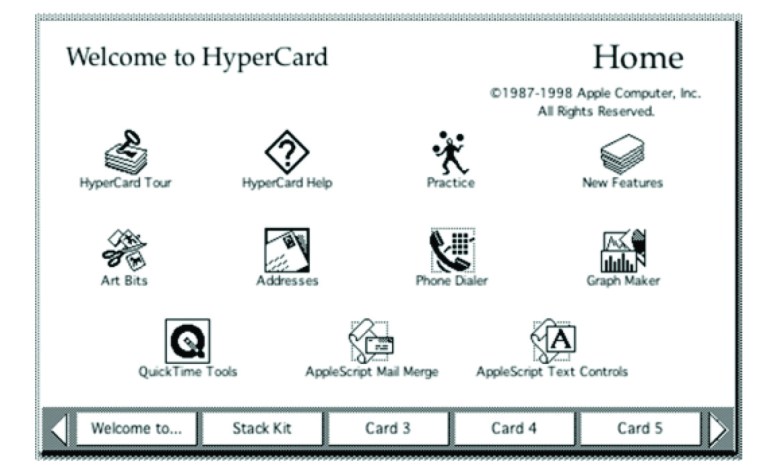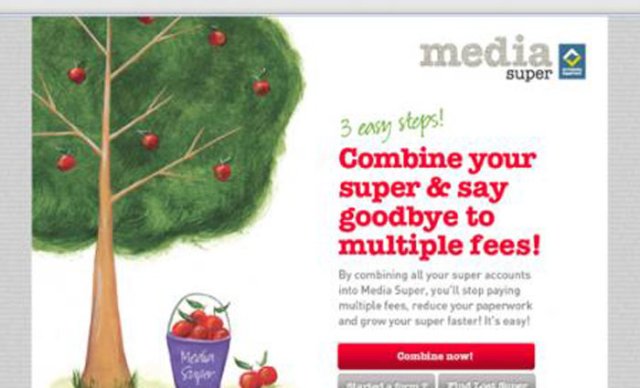
I remember (and many of you may as well) the venerable Hypercard. Hypercard was one of the Apple original software programmer’s Bill Atkinson’s baby. With the help of fellow Apple-original Dan Winkler, they created the application that introduced the world of hypermedia to the computing community in August 1987.
Keep in mind that this was all years before the advent of the worldwideweb, and there was a large disparity between computer users and computer programmers.
The world of creating content (more likened to programming), was still in the realm of programming, and therefore, the mount of tools and media that were available to the mere mortal computer user were sparse. When Bill Atkinson went to Steve Jobs, and showed him what was originally slated to be known as Wildcard, Steve agreed, and signed a deal – that Hyerpcard would be included in every new Macintosh. For free. At the end, for legal reasons it became Hypercard, and the Macintosh, nor what became the internet, was never again the same.
One of the stipulations that Bill Atkinson gave when he gave the code to Apple, was that it had to be free. This was a really good deal initially for Apple, who needed to prove the validity of the Macintosh as a computer platform and show that it had real-world applications. It was also a great deal for the Macintosh community. The Macintosh community had already begun to solidify itself as the multimedia and graphic production standard it became later on, but tools like Hypercard served to prove the point that digital media and digital media production techniques were becoming more mainstream, and that the world of programming content for computers did not have to live with an engineer.
So, Hypercard began to initiate a whole new industry of graphic professionals that had been accustomed to learning that the Macintosh was a perfect graphic and typesetting tool, and to facilitate their move towards digital media. All of a sudden, making hyperlinks and clickable icons was becoming the realm of the graphic professional, and not the programmer. It also meant that the people whom would soon begin programming the internet pages and languages we use every day, began to do so with tools like Hypercard. Now, they were the same graphic artists that were using Adobe Illustrator, Aldus PageMaker, and Freehand, and yes, even MacPaint.
So, being the nerdy Mac guy that I was in the late 1980s, I made a Christmas card stack that I sent to my Mac-savvy friends at Christmas time. I made an 800k 3.5” floppy disk with a stack full of clickable objects and sounds, and it was a really neat first effort at a digital greeting card. It was not difficult, and it was a great proof-of-concept to show the people that I had been trying to convince that the Macintosh was the ultimate graphic and media tool.
The Macintosh was a really great computer to show how the future of hypertext would work, as it had a mouse and Graphic User Interface all standard. As a result, those of us who took to the Macintosh at its birth, got an early sneak-preview of what the internet and modern interactive rich media would incorporate today.
I went to a lot of my magazine clients, and showed them how they could use Hypercard for interactive projects, special-sections, and ways to use the newly emergent media of CD-ROM publishing. They were impressed, but still came back with the obvious response, “But how many people have a computer that is capable of playing these Hypercard stacks?”. Which was indeed a valid concern. Once again, the internet and computer bulletin boards and services like Compuserve or America Online (AOL) came to the rescue of hypertext, and proved the validity of interactive and rich media for the masses.
What happened to Hypercard?
Well, eventually, Apple began to focus the Macintosh on even less technical markets. With the iMac, eMac and other entry-level Macintosh computers for education and media, the need for a true consumer-level programming tool became less and less a required necessity. Eventually, the rise of the www and hypertext followed much of the model of Hypercard, and obsoleted it. I still have to respect Bill Atkinson however, as it was his insistence the Hypercard be included free with all new Macintosh computers, which trained a world of people who understood hypertext/hypermedia. In the early world of the Macintosh, where there was precious little software available, having a free, media-rich programming language on Day One was a pretty nice benefit to your new Mac. After a 2.0 and a 3.0 revision, it was eventually deigned to be a sunset product, and no longer developed or supported.
So, thank you Bill Atkinson, and the other brave programmers who worked so hard to provide the Macintosh community with the ability to learn how to use their tools to invent a new media, the internet. Hypertext Markup Language (HTML) and others owe a lot of their initial design and capabilities to the experiences and capabilities of the initial builds of Hypercard.
Now that we are actively involved in discussions with many of our customers about how to produce content in parallel media production workflows for analogue and digital products, we can learn a great deal from the simplicity of Hypercard. Hypercard was easy, it was on everyone’s Mac, and – it was free.
Sometimes you have to look back at history in order to see the road we have travelled, and I can not help but to think that a lot of the world we live in today would look a lot different if there had not been people like Bill Atkinson giving us tools to make our computers slaves to our ideas instead of vice versa.
Comment below to have your say on this story.
If you have a news story or tip-off, get in touch at editorial@sprinter.com.au.
Sign up to the Sprinter newsletter


